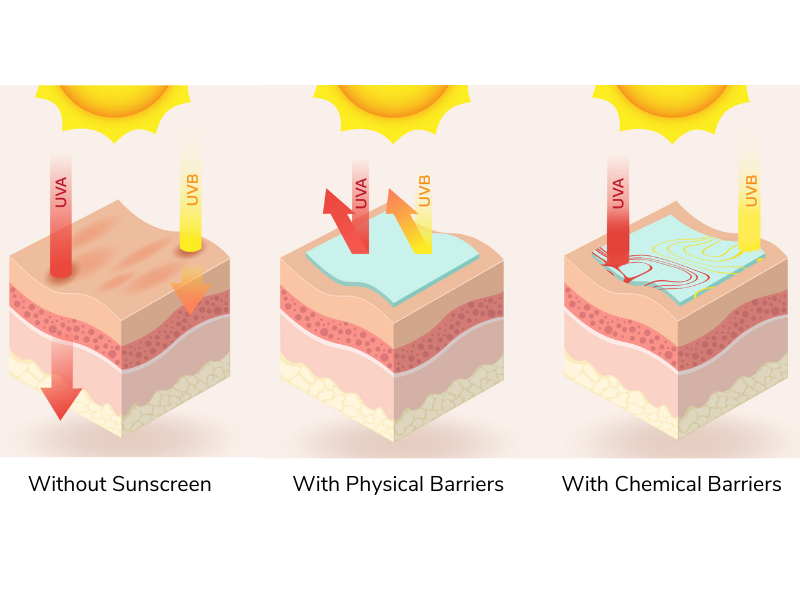How Does Sunscreen Protect Our Skin?
There’s nothing quite like basking in the sun… but careful not to overindulge! You could get a little too crispy! Using sunscreen can certainly be a great way to protect our skin, but how does it work exactly? How does it shield us from the sun’s rays?
Shielding Our Skin From the Sun’s UV Rays
The Sun emits rays, and some of these are ultraviolet rays, also called UV rays. Two types of UV rays reach us all the way here on Earth: UVA rays and UVB rays. Machines like tanning beds also emit UV rays. UVA and UVB rays can both damage the skin, but in different ways.
UVA Rays – A is for Age
UVA rays can penetrate the deep layers of our skin and cause cell damage. Over time, UVA rays can cause our skin to age more quickly than it should, which can mean wrinkles, age spots, and even certain kinds of skin cancers.
UVB Rays – B is for Burn
UVB rays are the ones mainly responsible for tanning our skin… or burning it! Gladly, redness and burns caused by the sun are only temporary, but it’s important to protect our skin from these kinds of rays because they are also linked to some kinds of skin cancers.

One way to avoid over-exposure to UVA and UVB rays is to wear sunscreen. Did you know that there were two different kinds of sunscreen? Read on!
Physical, Mineral, Chemical…?
Sunscreens are made to block UV rays before they penetrate our skin. Some are designed to act as a physical barrier, and some are designed to act as a chemical barrier. What’s the difference? UV rays bounce off a physical barrier, but get absorbed by a chemical one.
Sunscreens that Work as Physical Barriers
Sunscreens that work as physical barriers usually contain mineral ingredients like zinc oxide or titanium dioxide. Yes, zinc oxide, exactly the same ingredient found in creams used to treat diaper rash! What's titanium dioxide? It's a natural substance found in a mineral called ilmenite.
Since both these kinds of sunscreens are thick and white, they coat the skin with a layer of protection which deflects UV rays away from it.
Sunscreens that Work as Chemical Barriers
Instead of deflecting UV rays, chemical barrier sunscreens absorb them and dissipate them, transforming them into a mild form of heat. All sorts of ingredients can be found in chemical sunscreens, such as octyl salicylate which is transparent and oily and has a faint floral scent.
Some sunscreens use both approaches and include mineral and chemical ingredients. No matter which you choose, make sure it is a “wide spectrum” sunscreen which means that it offers protection against UVA and UVB rays.
What’s SPF all about?
SPF stands for “sun protection factor,” and it comes in the form of a number. This number tells you how much protection the sunscreen offers you and your skin against UVB rays. Remember that SPF doesn’t measure the strength of protection against UVA rays. That’s exactly why it’s important to choose a “wide spectrum” sunscreen; to ensure you are also protected against UVA rays.
It's Not Just a Question of Time!
The higher your sunscreen’s SPF, the more UVB rays are prevented from penetrating your skin. A sunscreen’s SPF number is sometimes understood as a measure of how long you can spend in the sun without risking skin damage, but it’s not actually tied to the length of time you spend under the sun; it’s about the amount of exposure to the sun’s rays. Calculating your exposure means thinking about the amount of time you spend in the sun as well as what time of day it is, where you are, the amount of cloud cover there is, and the kind of skin you have. For example, UV rays are stronger at noon than they are at nine in the morning. That means that in the space of 30 minutes, your skin is exposed to many more UV rays at lunchtime than it would be in the morning or evening.
What’s important to remember when it comes to protecting your skin from the sun is the amount of sunscreen you put on, and how often you put it on. Applied properly, an SPF15 sunscreen will block about 93% of UVB rays. An SPF30 sunscreen will block about 97%. That’s how using sunscreen can help you reduce the risks of being exposed to the sun for long periods of time. Reapplying it every two hours is your best strategy and, imagine that, that’s exactly what experts recommend!
Have a great time in the sun everyone!
